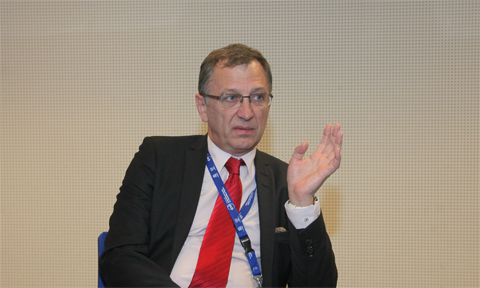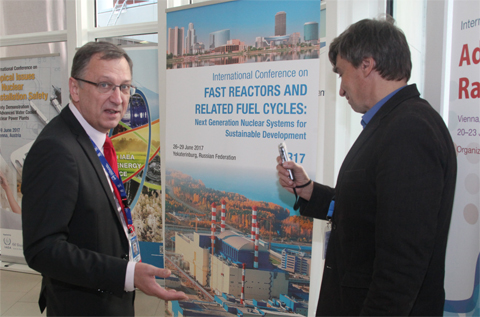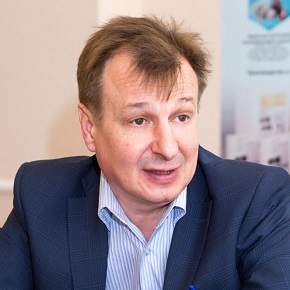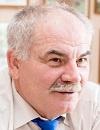 |
||
|
Vladimir Krivientsev: FR17 - The Olympic Games of Fast Reactors AtomInfo.Ru, PUBLISHED 31.10.2016 Vladimir Krivientsev, leader of the Fast Reactor Technology Development team in the IAEA's Department of Nuclear Energy, answers questions from correspondents for the electronic publication AtomInfo.Ru. CONTINUED BELOW Vladimir Krivientsev, (c) AtomInfo.Ru  Workshop in Trieste Mr Krivientsev, we understand that the IAEA held a workshop on fast reactors this year in Trieste. We know that it was well received by two Russian participants. Now we would like to hear your opinion as one of the organizers. The organizers were also very pleased. I should point out, though, that there were more than two people from Russia taking part. There were six, if memory serves. The workshop focused on the physics and technology of innovative nuclear energy systems for sustainable development. Our aim was to bring together a group representing the next generation of experts to talk to them about the next generation of reactors and the associated fuel cycles. That sounds a bit broad. What specific topics did you address? We started, as one does, with an introduction, in which we talked about why there was a need for new fuel cycles and fast reactors and whether there is even a need for them. We looked at different ways nuclear power might develop, based on UN forecasts concerning the growth in global energy demand, how long existing uranium reserves will last, and so on. After the general introduction, we looked into more specific areas, such as the physics of innovative (fast) reactors, neutronics, safety, materials, including construction materials, coolants, fuel and the thermal hydraulics specifically of fast reactors. We had many well known scientists giving the lectures. Heading the list we had Massimo Salvatores... The Russian participants we have spoken with very much appreciated the opportunity to meet Salvatores in person and hear him speak. From France we had Christian Latge, an expert in fuel and materials. His lectures were also well received. Concetta Fazio of the European Commission's Joint Research Centre gave lectures on construction materials. We also had Andrei Rineiski, a well-known expert on fast reactor safety, who is currently working at the Karlsruhe Institute of Technology. And yours truly lectured on thermal hydraulics. All these lectures can be accessed from the IAEA's web page for the workshop. How were participants selected? We received some 140 applications, which was much more than we could accept. To make the selection we devised a number of objective criteria. For example, if an applicant had some experience in physics he or shewould get six points, making them eligible, in principle, to participate in the workshop. Nuclear reactor-relevant experience is worth another point. If there were recommendations, that's another point. Scientific publications are worth a point, and if the publicationsare related to next generation reactors, that's another point. The need to ensure balanced geographical representation also played a role. In addition, the Abdus Salam International Centre for Theoretical Physics (ICTP), which organized the workshop jointly with the IAEA, applied its own criteria. Some financial support was also made available to applicants from developing countries. Russia at this point is no longer in that category. While that is good news, it also means that participants from Russia had to make financial arrangements individually. In the end, we were able to put together a rather strong group for the workshop. At the same time, unfortunately, there was no one from China. Yes, that surprised us. How did that happen? It is difficult to say for certain. Perhaps we could have done a better job of providing information on the event. We will bear this in mind in the future. There were no applications at all from France, but that is easier to explain. They were running their own school at almost the same time as ours. It was nice to see good representation from Latin America, including Argentina, Brazil, Cuba, Mexico and Peru. There were also participants from Asia, Africa and Europe. Altogether we had about 40 participants from 24 countries. We understand there was a poster session for the participants. Yes, we introduced two additional events on the programme specifically in order to encourage more participant involvement. The first was that we invited all those interested to prepare and give a poster presentation. All those interested or everyone? It was not a requirement, but most of the participants did it. As a result, we had quite a good event and we spent two evenings on it. When it was over, the organizers gave an award to a participant from India for a high-quality and professional presentation. The other item added to the programme was a team-work project. We made four teams and set them two homework assignments: "invent" a new passive emergency shutdown system and perform a thermal hydraulic calculation for a reactor core. All the teams successfully completed the second task. As for the first task, we of course did not expect them to invent a new system in one evening. Nevertheless, some teams did come up with something, while others reviewed existing passive shutdown system designs, which was also not bad. Are you planning to hold more fast reactor workshops? Certainly. It is a little early, though, to say exactly where next year's workshop might be held. Vladimir Krivientsev, (c) AtomInfo.Ru  FR17 Conference The FR17 conference on fast reactors is being held in 2017 in Yekaterinburg. Who is organizing it? The FR17 is a major conference on fast reactors and related fuel cycles that is being organized by the IAEA. I would like to take this opportunity to thank the Government of the Russian Federation, represented by Rosatom, for agreeing to host the conference and for arranging for the participants a visit to the Beloyarsk NPP and the brand-new Russian BN-800 fast reactor. The conference will be the third of its kind. The first was held in 2009 in Kyoto, Japan, and the second was in Paris in 2013. Now, it is Russia's turn. The FR conferences are the largest fast reactor events in the world. In terms of their significance and how often they are held, you could compare them with the Olympic Games. Preparations for FR17 are in full swing. From an organizer's standpoint it's a complex event requiring a great deal of effort and coordination. Which IAEA Department is directly responsible for organizing FR17? The Department of Nuclear Energy, headed by Mikhail Chudakov. Within the Department, the project has been assigned to the Nuclear Power Technology Development Section, to which I belong, and the Nuclear Fuel Cycle and Nuclear Fuel Cycle and Materials Section. The full title of the FR17 Conference is the International Conference on Fast Reactors and Related Fuel Cycles: Next Generation Nuclear Systems for Sustainable Development. As you know, it will take place from 26 to 29 June 2017. Details can be found on the IAEA's website. How far along are preparations for the conference? The main committees have been formed, including the International Scientific Programme Committee, which has already begun work. The deadline for the submission of abstracts is 30 September 2016. This may have to be extended a little, but I do know that we have already received over 100 submissions.
The next step will be assigning the submissions to tracks and sessions and then asking the authors to submit their full papers for review. So the papers are going to be reviewed? As you know, different conferences deal with the selection process differently. We decided that for a high-level event such as FR17, it was just not fitting to select the papers based only on abstracts (up to 400 words), so we intend to put the papers through a full-scale peer-review by independent reviewers. How will the proceedings of the conference be published? We plan to publish them as a proceedings book. They will also be available electronically on the IAEA's website. As for the texts of the papers, as is often the case at conferences, we may not have time to publish the final versions on paper before the start of the conference. However, each participant will receive a collection of the draft versions in electronic form. When can we expect to see the conference programme? For that, one needs first to figure out how many papers will be given in each session. Then the programmes can be drawn up for each session, for the plenary... The final programme, of course, will be available nearer to the start of the conference, in April or May 2017, I would say. You mentioned the tour to the Beloyarsk nuclear power plant with its BN-600 and BN-800 reactors that has been planned as part of the conference. Yes, it is planned, but Rosatom will be organizing it. The Agency is responsible for the conference itself. I can tell you tentatively that the tour will take place on Friday, 30 June 2017. The number of participants is limited, so I encourage anyone interested in visiting the plant to apply early. Is it possible already to identify the countries most interested in taking part in FR17? The answer is obvious: France, China, India, Japan and South Korea. Naturally, we are expecting many participants from Russia, among the world leaders in fast reactors, but I encourage those in Russia to send in their abstracts as soon as possible and not rely on the deadline being extended. Thank you, Mr Kriventsev, for speaking with the electronic publication AtomInfo.Ru. Thank you to the editorial staff of AtomInfo.Ru, one of the mostwell-respected sources of "nuclear" news, and best wishes to your readers! Vladimir Krivientsev, (c) AtomInfo.Ru  Other news: 443 nuclear units are operating in the world Another 65 units have the status of the being built one. New American submarine will be named after admiral Rickover 60th anniversary of the first trip of the nuclear submarine Nautilus. Westinghouse will deliver CE16NGF fuel on Palo Verde This is a new generation fuel for 16×16 grid. |
Hero of the day 
Dmitry Klinov: BFS is being renewed The task of the BFS retrofitting and upgrading arose in late 2010 as a consequence of the enormous difficulties that we had encountered in renewing the licence to operate our fast critical facilities. INTERVIEW
Oleg Grudzevich OPINION
Rudolf Baklushin |

